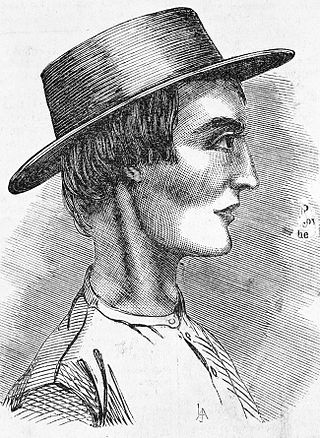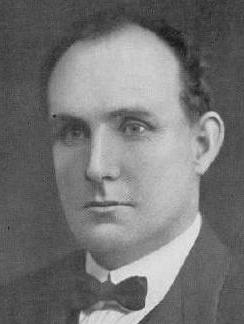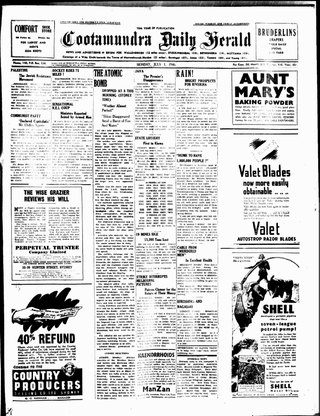Related Research Articles

Gundagai is a town in New South Wales, Australia. Although a small town, Gundagai is a popular topic for writers and has become a representative icon of a typical Australian country town. Located along the Murrumbidgee River and Muniong, Honeysuckle, Kimo, Mooney Mooney, Murrumbidgee and Tumut mountain ranges, Gundagai is 390 kilometres (240 mi) south-west of Sydney. Until 2016, Gundagai was the administrative centre of Gundagai Shire local government area. In the 2021 census, the population of Gundagai was 2,057.

Cootamundra, nicknamed Coota, is a town in the South West Slopes region of New South Wales, Australia and within the Riverina. It is within the Cootamundra-Gundagai Regional Council. At the 2016 Census, Cootamundra had a population of 6,782. It is located on the Olympic Highway at the point where it crosses the Muttama Creek, between Junee and Cowra. Its railway station is on the Main Southern line, part of the Melbourne-to-Sydney line.

John Dunn was an Australian bushranger. He was born at Murrumburrah near Yass in New South Wales. He was 19 years old when he was hanged in Darlinghurst Gaol. He was buried in the former Devonshire Street Cemetery in Sydney.

Jugiong is a locality and town on the banks of the Murrumbidgee River near its confluence with Jugiong Creek. in the Hilltops Council Local Government area, New South Wales, Australia. It is situated just off the Hume Highway, by road, about 30 kilometres southwest from Bookham and 40 kilometres northeast from Gundagai.

Thomas James Lavelle was an Australian politician. He was an Australian Labor Party member of the Australian House of Representatives from 1919 to 1922, representing the electorate of Calare.
The Protestant Independent Labour Party, alternatively spelt Protestant Independent Labor and sometimes known as the Protestant Labour Party, was a minor Australian political party that operated mainly in New South Wales, Queensland and South Australia in the 1920s and 1930s. It was formed by Walter Skelton in July 1923 as the Protestant Independent Labour Party. who had stood for the New South Wales Legislative Assembly district of Newcastle at the 1922 election, campaigning as a Protestant Independent Labour candidate, in which he was elected first of five members, receiving 25.19% of the vote. In 1925 he was re-elected to the Assembly under the Protestant Labour label, as the second of five members, receiving 17.70% of the vote. The party stood candidates in 12 of the 24 districts however Skelton was the only one elected, with the next highest candidate receiving 5.10% of the district vote.
Around the Boree Log is a 1925 Australian silent film by Phil K. Walsh adapted from the poems of "John O'Brien". It tells stories of a priest's life around the 1870s in the Goulburn area.

The Burrowa News and Marengo, Binalong, Murrumburrah and Cootamundra Reporter was a weekly English language newspaper published in Boorowa, New South Wales, Australia.
The Maher Cup was an Australian rugby league challenge cup contested between towns of the South West Slopes and northern Riverina areas of New South Wales between 1920 and 1971. The main teams involved were Cootamundra, Tumut, Gundagai, Temora, West Wyalong, Young, Harden-Murrumburrah, Junee, Barmedman, Cowra, Grenfell and Boorowa.

The Binalong railway station and telegraph office is the older of two closed railway stations in Binalong on the Main Southern railway line in New South Wales, Australia. The station opened in November 1876 as the terminus of the Bowning-Binalong section of the line. Following a fire to the original wooden building in 1883, a new stone and brick building was constructed. This was in use until 1916 when the line was deviated in conjunction with duplication. The station house and telegraph office remain today as a building of important historical significance in the town.

The Cootamundra Herald is a former printed bi-weekly newspaper now existing only on-line and containing little or no news of direct relevance to the community of Cootamundra, New South Wales, Australia. The Herald website carries syndicated non-local copy with occasional government media releases referring to local issues. Following the purchase of the masthead in 2019 by Australian Community Media, the Herald office which had existed for 144 years in the main street was closed and local staff were forced to work part-time from home. The staff resigned or were eventually sacked, and there are now no local Herald employees generating content related to the town.
Robert Thomas Donaldson was an Irish-born Australian politician.
John Frederick Barnes was an English-born Australian politician.
Thomas Frederic De Courcy Browne was an Irish-born Australian politician and journalist.
The Electoral district of Pastoral Districts of Lachlan and Lower Darling was an electorate of the New South Wales Legislative Council at a time when some of its members were elected and the balance were appointed by the Governor. It was a new electorate created in 1851 by the expansion of the Legislative Council to 54, 18 to be appointed and 36 elected. The district covered the south west of New South Wales was named after the Lachlan and Darling Rivers. On its eastern side were the districts of County of Bathurst and Counties of King and Georgiana, to the north was the Pastoral Districts of Wellington and Bligh and to the south was the Counties of Murray and St Vincent. Polling was to occur in the towns of Binalong, Wagga Wagga, Balranald, Canowindra, Gundagai and Yass.
Phillip Kenny Walsh, invariably referred to as Phil Walsh or Phil K. Walsh, was an Australian stage actor and producer who made several feature films which still exist, unusually for those made during the "silent era".
A by-election was held for the New South Wales Legislative Assembly electorate of Goldfields South on 16 November 1863 because Bowie Wilson had been appointed Secretary for Lands in the first Martin ministry. Such ministerial by-elections were usually uncontested and on this occasion, Peter Faucett (Yass), William Forster and Arthur Holroyd (Parramatta) were unopposed. Of the other two contested elections, Geoffrey Eagar was easily re-elected, with more than 90% of the vote, while James Martin was defeated at the Orange by-election. Martin promptly regained a seat in parliament by winning the by-election for The Tumut.
A by-election was held for the New South Wales Legislative Assembly electorate of Gundagai on 21 November 1884 because of the resignation of Bruce Smith, to return to Melbourne to run his father's business, WM Howard Smith and Sons Ltd.
Kangiara is a locality, in the Yass Valley Council local government area, within the Southern Tablelands of New South Wales, Australia. There was once a mining village of the same name.
Lost River is a locality, in the Upper Lachlan Shire, within the Southern Tablelands of New South Wales, Australia. It lies on either side of the main road between Crookwell and Boorawa, which are the nearest towns to it.
References
- 1 2 3 Andrew Pike and Ross Cooper, Australian Film 1900–1977: A Guide to Feature Film Production, Melbourne: Oxford University Press, 1998, 146.
- 1 2 "Australian Films". The Sydney Morning Herald . National Library of Australia. 23 February 1927. p. 16. Retrieved 6 August 2012.
- ↑ "Australian Production Budget Drops Ninety Thousand Pounds This Year.", Everyones., 9 (459 (12 December 1928)), nla.obj-590190846, retrieved 7 March 2024– via Trove
- ↑ "Early Marriage". The Advocate . Burnie, Tas.: National Library of Australia. 26 July 1927. p. 8. Retrieved 22 February 2012.
- ↑ "Movie Film Shot at Young Back in 1928". Boorowa News . New South Wales, Australia. 21 August 1953. p. 3. Retrieved 24 February 2020– via Trove.
- ↑ "Nostalgia in old stills". The Canberra Times . Australian Capital Territory, Australia. 12 December 1970. p. 12. Retrieved 24 February 2020– via Trove.
- ↑ "Local and General". The Yass Courier . New South Wales, Australia. 29 November 1926. p. 5. Retrieved 24 February 2020– via Trove.
- ↑ "Personal". Cootamundra Herald . New South Wales, Australia. 24 May 1927. p. 2. Retrieved 24 February 2020– via Trove.
- ↑ "Film Record". The Sun (Sydney) . New South Wales, Australia. 11 May 1927. p. 17. Retrieved 24 February 2020– via Trove.
- ↑ "About People". The Gundagai Independent and Pastoral, Agricultural and Mining Advocate . New South Wales, Australia. 13 June 1927. p. 2. Retrieved 24 February 2020– via Trove.
- ↑ "Birth of White Australia". The Burrowa News . New South Wales, Australia. 1 July 1927. p. 6. Retrieved 24 February 2020– via Trove.
- ↑ "Pastoralists in Film Scene". The Land . New South Wales, Australia. 19 August 1927. p. 3. Retrieved 24 February 2020– via Trove.
- ↑ "Famous Actor and Actresses Join Dominion Films". The Burrowa News . New South Wales, Australia. 17 February 1928. p. 5. Retrieved 24 February 2020– via Trove.
- ↑ "Up a Tree at 98 !". The Gundagai Independent and Pastoral, Agricultural and Mining Advocate . New South Wales, Australia. 16 February 1928. p. 1. Retrieved 24 February 2020– via Trove.
- ↑ "New Film". The Sydney Morning Herald . National Library of Australia. 25 July 1928. p. 17. Retrieved 22 February 2012.
- ↑ "An Australian Film". The Sydney Morning Herald . National Library of Australia. 23 May 1927. p. 16. Retrieved 6 August 2012.
- ↑ "The Birth of a White Australia". The Young Chronicle . New South Wales, Australia. 4 September 1928. p. 2. Retrieved 24 February 2020– via Trove.
- ↑ "The Show Ends". The Young Chronicle . New South Wales, Australia. 7 September 1928. p. 1. Retrieved 24 February 2020– via Trove.
- ↑ "Advertising". The Sydney Morning Herald . National Library of Australia. 21 May 1931. p. 1. Retrieved 6 August 2012.
- ↑ "A gentleman of the mountains". The Canberra Times . Australian Capital Territory, Australia. 24 February 1979. p. 15. Retrieved 24 February 2020– via Trove.
- ↑ "Birth of White Australia: Notes". NFSA. Retrieved 24 February 2020.
- ↑ "Jonathan Dennis talks about". Filmnews . New South Wales, Australia. 1 April 1994. p. 16. Retrieved 24 February 2020– via Trove.